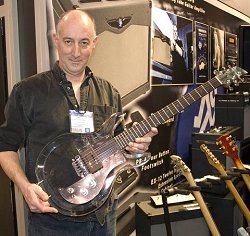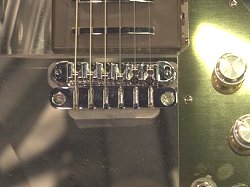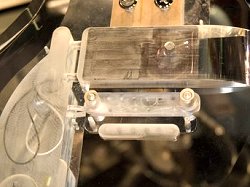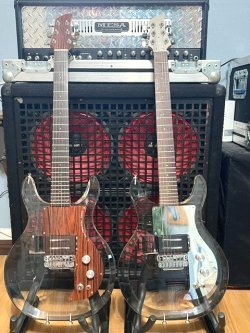
Two years would pass before Ampeg would release a new Dan Armstrong acrylic bass. As stated earlier in this section,
my inside source at Ampeg mentioned "we wanted to see how well the guitar model went over before we went ahead
with the bass." Apparently things must have looked pretty good for on January 17th through the 20th
the Dan Armstrong ADA4 reissue bass guitar made its debut in booth #5776 at the 2008 NAMM Convention
in Anaheim, California.
Above left, at the 2008 NAMM show Bill Richardson tries out the new Dan Armstrong ADA4 bass. Like it's
1998-2001 predecessors it features a 30" scale neck which is made of 3-piece laminated maple with a 24-fret Indian
rosewood fingerboard along with a rosewood bridge that employs compensating brass saddle pieces for intonation. It's
topped off with Grover nickel die-cast tuners and, as mentioned earlier, it comes with the two
aforementioned Kent Armstrong interchangeable pickups. Notice the use of a clear guitar strap going
over Bill's shoulder. All photos on this page are courtesy of Bill Richardson.
At upper right, Bill tries out yet another reissue Dan Armstrong bass that features a chrome scratchplate and headstock
veneer. Ampeg sources say although this bass was at the NAMM show "it's a specialty custom type bass for the
show and not part of our stocking bass instruments which will begin shipping in July of 2008."
Above left and right the ADA4 bass wasn't the only specialty instrument at booth #5776 however, There was the ADA6
lead guitar model that also featured a chrome scratchplate and headstock. This is virtually the same identical type
instrument that I saw John Kay playing when I went to a Steppenwolf concert in 1975.
However, unlike John Kay's guitar, and shown here in closer view, this guitar reveals even more features than just the
chrome surroundings standing in for the wood grain trimmings. This guitar came stock with a Wilkinson tuno-matic
type bridge and tailpiece. The tailpiece fitted onto prior Dan Armstrong guitars appears to have been reduced in size by about half - leaving
just enough mass for the strings to attach to the tailpiece, while immediately in front of it lies the new tunable type bridge.

|
As seen at left, luthier Bill Richardson poses with the Dan Armstrong ADA6 custom guitar featured above. At that time the
guitar was a prototype. The 'rumor mill' back then was talk of Ampeg producing models exactly like this, with the all chrome
surroundings but with very few exceptions they never really materialized.
There were Dan Armstrong acrylic guitars that shipped with the Tuno-Matic type bridge as seen here however. I was hoping many more were going to
be produced to stop, or at least greatly slow down the usual modifications to the original instruments. Unfortunately (in my opinion), not nearly
enough were made, before production of these instruments would halt.
|

|

|
As seen upper left, a closer view of the Wilkinson tuno-matic type bridge and the newly designed tailpiece. Notice only
two screws securing down the tailpiece. At upper right, and as seen from the backside, the routing of the acrylic
for the bridge & tailpiece can be seen.

|
At left, two latter day Dan Armstrong · Ampeg guitars. Both instruments feature Wilkenson tunable bridges. The
guitar at left features the original faux-wood type scratchplate and headstock veneer - while at right, a 40th Anniversary model sports a
metal/mirror styled scratchplate and headstock. Photos are courtesy of Eric Bartholomae.
|
At left and right, a closer look at the two instruments. Notice the ST type pickup at left is brown, while at right it's black.
On the left, notice how the switch on the older reissue model is taller than that on the 40th Anniversary model seen at right.
At first, I thought the differences was perhaps due to the thickness of the scratchplates, but then I noticed that Eric had taken his
measurements from the top of the threads of the switch-barrels - meaning the scratchplate thickness has no bearing on these measurements
at all. For whatever reasons, Ampeg had used different brands, or at least a different design of SPDT switch, on their 40th Anniversary
models.
Eric also noticed a difference in the feel of the switches, stating "The selector switch on the 40th Anniversary model has a shorter
bat handle on it which feels stiffer than the switch on the other guitar." I'm guessing he had already come to the conclusion that
since the bat handle on the 40th Anniversary model is shorter, it just takes more effort to work the switch. The question here is, why
the change in switches? I mean, it hasn't been decades between these two guitar models like it was with the original 1969-71 models
to the first reissues in 1998-99. That, at least, was understandable, but these two instruments are only a year or two apart at most.
Another difference. At left the earlier model features Gotoh tuners on the headstock which from the front - have the look of Schaller
tuners seen on early Dan Armstrong models, while on the 40th Anniversary model Ampeg chose to use Grover Rotomatic tuners. It is
unknown as to why different tuners were employed from one model to another in such a brief period of time.
As seen above, and according to Eric, "The pickup thumb screw on the 40th Anniversary model is shorter than on my earlier Dan
Armstrong reissue. The thumbscrew is barely able to grip the threads on the pickup. So Iíve ordered a longer replacement." Here
again, and like the selector switches mentioned above - why the change? Given the buying power of the Ampeg Company these anomalies
shouldn't have cropped up like this - yet there it is.
At left Eric's 40th Anniversary Dan Armstrong features a stamped, or inked-in logo on the tongue of the neck showing it to be a 40th
Anniversary Dan Armstrong guitar model. At right, certain 40th anniversary models sport an etched Ampeg
a on the body.
Sometime in late 2009 or early 2010, Ampeg discontinued the latest version of the Dan Armstrong re-issue instruments, going out
in style with their 40th Anniversary models. When I spoke with Scott Paterson at Ampeg in 2010 or 2011 as to whether they would release
more Dan Armstrong instruments in the future, he replied, stating "The Dan Armstrong instruments have not been discontinued, but are
temporarily 'on hold' as we don't want to saturate the market with them. Instead, we want to keep them as an anniversary item and
periodically release them from time to time."
Unfortunately, that would seem to be the last word on the subject, as another era had come to an end. For as early as 2014 Loud
Technologies let the trademark expire on the actual design rights of the Dan Armstrong guitar which was eventually acquired by Mr. Mark
Stevens of Seattle - who made some two-pickup prototypes of the Dan Armstrong guitar. Unfortunately, these instruments did not seem to
generate enough interest to continue. Furthermore, Mr. Stevens did not own the Dan Armstrong trademark name, so everything pretty-much
fell apart. Mr. Stevens is currently selling pickups for the Dan Armstrong instruments under the name 'Seattle Guitar Shop' on Reverb,
though buyers are reporting that their funds are being returned when they purchase his pickups - so it's all very confusing.
Fast-Forward to May 10th 2018 - the Yamaha Guitar Group acquired Ampeg from LOUD Audio. Commonly referred to as 'Yampeg' by musicians
since - to date, Yamaha has not produced any Dan Armstrong · Ampeg instruments at all. It remains to be seen
whether the Dan Armstrong · Ampeg guitar will ever make a return - or if it slowly fades into history.
menu
Names and images are TMand © Dan Armstrong / Ampeg. All rights reserved.
All other names and images are TMand © of their respective owners. All rights reserved.
|
| |

